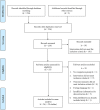Effects of the Best Possible Self intervention: A systematic review and meta-analysis
- PMID: 31545815
- PMCID: PMC6756746
- DOI: 10.1371/journal.pone.0222386
Effects of the Best Possible Self intervention: A systematic review and meta-analysis
Abstract
The Best Possible Self (BPS) exercise promotes a positive view of oneself in the best possible future, after working hard towards it. Since the first work that attempted to examine the benefits of this intervention in 2001, studies on the BPS have grown exponentially and, currently, this is one of the most widely used Positive Psychology Interventions. However, little is yet known about its overall effectiveness in increasing wellbeing outcomes. Thus, the aim of this meta-analysis is to shed light on this question. A systematic literature search was conducted, and 29 studies (in 26 articles) met the inclusion criteria of empirically testing the intervention and comparing it to a control condition. In addition, BPS was compared to gratitude interventions in some of the included studies. A total of 2,909 participants were involved in the analyses. The outcome measures were wellbeing, optimism, depressive symptoms, and positive and negative affect. Results showed that the BPS is an effective intervention to improve wellbeing (d+ = .325), optimism (d+ = .334) and positive affect (d+ = .511) comparing to controls. Small effect sizes were obtained for negative affect and depressive symptoms. Moderator analyses did not show statistically significant results for wellbeing, except for a trend towards significance in the age of the participants (years) and the magnitude of the intervention (total minutes of practice). In addition, the BPS was found to be more beneficial for positive and negative affect than gratitude interventions (d+ = .326 and d+ = .485, respectively). These results indicate that the BPS can be considered a valuable Positive Psychology Intervention to improve clients' wellbeing, and it seems that it might be more effective for older participants and with shorter practices (measured as total minutes of practice).
Conflict of interest statement
The authors have declared that no competing interests exist.
Figures
References
-
- Cohen J. Statistical power analysis for the behavioral sciences. 2nd ed Hillsdale: Erlbaum; 1988.
-
- King LA. The health benefits of writing about life goals. Personal Soc Psychol Bull. 2001;27: 798–807.
Publication types
MeSH terms
LinkOut - more resources
Full Text Sources
Miscellaneous




